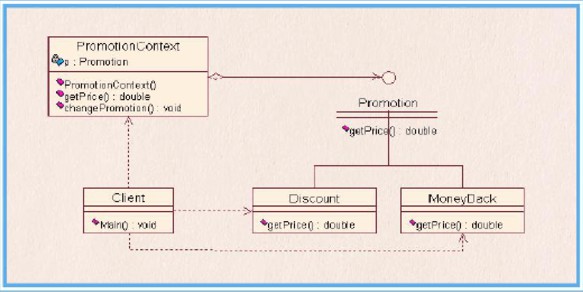您好,登錄后才能下訂單哦!
您好,登錄后才能下訂單哦!
小編給大家分享一下C#策略模式的示例分析,相信大部分人都還不怎么了解,因此分享這篇文章給大家參考一下,希望大家閱讀完這篇文章后大有收獲,下面讓我們一起去了解一下吧!
所謂策略其實就是做一件事情有很多很多的方法,比如說一個商場要搞促銷,促銷的方式有可能有很多:打折啊,滿100返50啊、積分等等之類的。這種不同的促銷方式在我們系統中表示就是一個一個的策略,并且策略是可以隨時更換的,這個時候在設計系統時就可以使用策略模式。
商場有可能會更換或追加新的促銷模式,也就是策略存在調整,也就是會更改以前的代碼,為了滿足開閉原則,這時就要使用抽象類和接口,這里我們偏向使用接口。在接口里面定義策略的方法,根據不同的情況編寫不同的實現類,實現不同的策略,策略模式比較適用于算法經常變化的情況,比如計算工資的方式、出行方式的選擇等等。

如圖所示,我們先定義策略的接口(Promotion),然后在這個策略接口里定義策略的方法(GetPrice()),接著我們定義了兩種具體的策略(Discount打折)和(MoneyBack返現)。
策略模式會專門有一個上下文對象(PromotionContext)專門管理策略類,并且上下文對象和策略接口之間是聚合的關系,也就是整體和部分的關系,因此在上下文對象里應該保存一個促銷類型的引用,另外上下文對象里一般會有一些方便客戶端調用的方法,如GetPrice()。客戶端程序可以通過上下文對象得到價格,這個GetPrice()里會根據不同的策略,執行不同的策略方法。
如果客戶端不想使用上下文中定義的默認的策略,也可以去修改策略類,因為上下文中有一個ChangePromotion()的方法,客戶端主要使用上下文對象,如果需要修改策略,他還要依賴于具體的策略對象。
1、策略接口:
using System;
using System.Collections.Generic;
using System.Linq;
using System.Text;
using System.Threading.Tasks;
namespace 策略模式
{
/*
策略接口
*/
public interface IPromotion
{
/// <summary>
/// 根據原價和策略計算新價格
/// </summary>
/// <param name="originPrice">原價</param>
/// <returns></returns>
double GetPrice(double originPrice);
}
}2、Discount打折策略類
using System;
using System.Collections.Generic;
using System.Linq;
using System.Text;
using System.Threading.Tasks;
namespace 策略模式
{
/// <summary>
/// 打折策略類
/// </summary>
public class Discount :IPromotion
{
public double GetPrice(double originPrice)
{
Console.WriteLine("打八折:");
return originPrice * 0.8;
}
}
}3、MoneyBack返現類
using System;
using System.Collections.Generic;
using System.Linq;
using System.Text;
using System.Threading.Tasks;
namespace 策略模式
{
/*
返現策略類:滿100返50的策略
*/
class MoneyBack :IPromotion
{
public double GetPrice(double originPrice)
{
Console.WriteLine("滿100返50");
return originPrice - (int)originPrice / 100 * 50;
}
}
}4、策略上下文類
using System;
using System.Collections.Generic;
using System.Linq;
using System.Text;
using System.Threading.Tasks;
namespace 策略模式
{
/*
策略上下文,為客戶選擇合適的策略
*/
public class PromotionContext
{
private IPromotion p = null;
public PromotionContext(IPromotion p)
{
this.p = p;
}
public double GetPrice(double originPrice)
{
// 默認策略
if (this.p == null)
{
this.p = new Discount();
}
return this.p.GetPrice(originPrice);
}
/// <summary>
/// 更改策略的方法
/// </summary>
/// <param name="p"></param>
public void ChangePromotion(IPromotion p)
{
this.p = p;
}
}
}5、主程序調用
using System;
using System.Collections.Generic;
using System.Linq;
using System.Text;
using System.Threading.Tasks;
namespace 策略模式
{
class Program
{
static void Main(string[] args)
{
// 默認策略:打八折的策略
PromotionContext pc = new PromotionContext(null);
Console.WriteLine(pc.GetPrice(200)) ;
// 更改策略:滿100返50的策略
pc.ChangePromotion(new MoneyBack());
Console.WriteLine(pc.GetPrice(155.9));
Console.ReadKey();
}
}
}以上是“C#策略模式的示例分析”這篇文章的所有內容,感謝各位的閱讀!相信大家都有了一定的了解,希望分享的內容對大家有所幫助,如果還想學習更多知識,歡迎關注億速云行業資訊頻道!
免責聲明:本站發布的內容(圖片、視頻和文字)以原創、轉載和分享為主,文章觀點不代表本網站立場,如果涉及侵權請聯系站長郵箱:is@yisu.com進行舉報,并提供相關證據,一經查實,將立刻刪除涉嫌侵權內容。